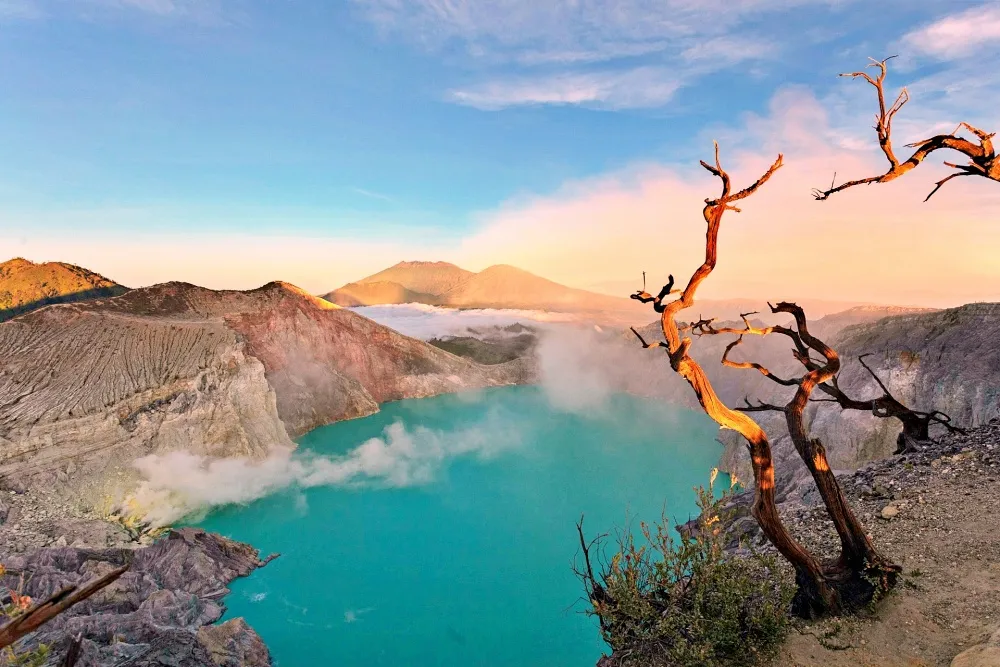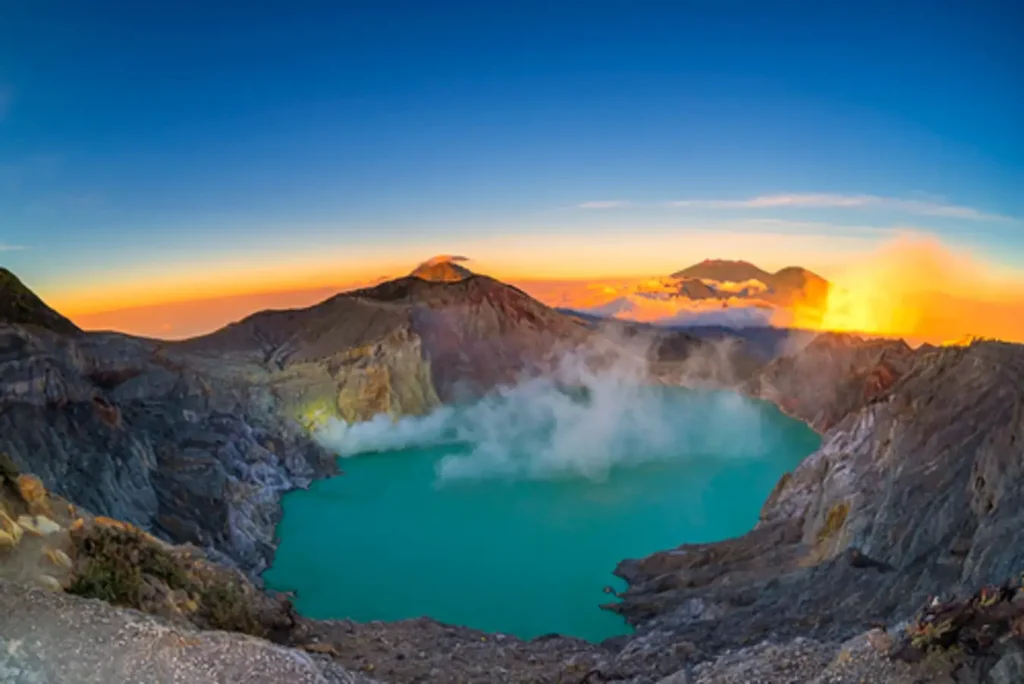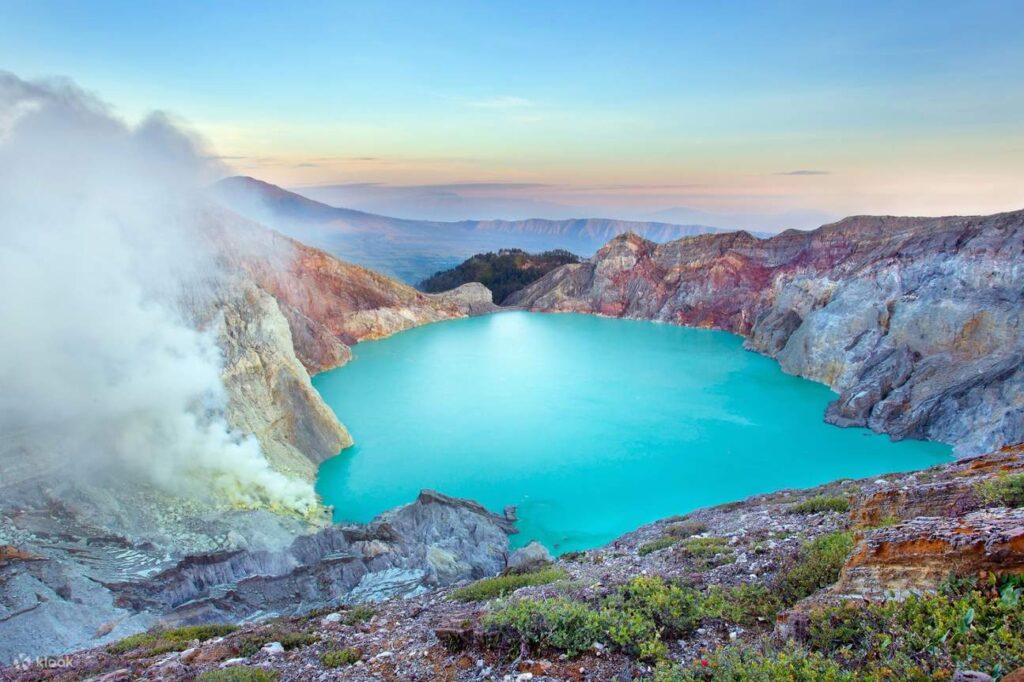Ijen Crater Weather: What You Need to Know Before Visiting
Planning a trip to Ijen Crater? Understanding the weather conditions is crucial for a comfortable and enjoyable experience. In this section, we will provide you with all the essential information about the climate and seasonal variations at Ijen Crater.
Key Takeaways:
- Knowing the weather conditions at Ijen Crater Weather is important for a successful visit.
- The climate at Ijen Crater can vary throughout the year.
- Understanding temperature, rainfall, and other factors can help you plan your trip accordingly.
- Challenges related to weather conditions can be mitigated with proper precautions.
- Valuable tips can help enhance your experience regardless of the weather.
Ijen Crater Climate Overview
Before embarking on your journey to Ijen Crater, it’s crucial to understand the weather conditions and what to expect during your visit. The climate at Ijen Crater is categorized as tropical, which means it is hot and humid throughout the year, with minor variations depending on the season.
During the dry season (May to September), the Ijen Crater weather is relatively stable, and the temperatures are warm, with an average of 27°C (80°F) during the day and 18°C (64°F) at night. However, during the rainy season (October to April), the Ijen Crater weather conditions can be unpredictable, and temperatures can fluctuate, with regular rain showers and high humidity.
The rainfall pattern at Ijen Crater is bimodal, meaning it has two distinct rainfall peaks each year, one from November to December and the other from April to May. The rainfall amount typically varies between 2,700 mm (106 inches) to 3,000 mm (118 inches) annually.
Ijen Crater Temperature Variations
The temperature at Ijen Crater can vary depending on the time of day, season, and altitude. It’s generally cooler in the mornings and evenings, with the temperature reaching its peak during midday. During the dry season, the temperature can reach 32°C (90°F), while during the rainy season, it can drop to 20°C (68°F).
If you plan on hiking to the crater’s rim to witness the blue flames, you need to be aware that the temperature can drop to 5°C (41°F) due to the high altitude. It’s crucial to pack appropriate clothing and gear to keep yourself warm and comfortable during your visit.
Rainfall Patterns and Precipitation
As mentioned earlier, the rainfall pattern at Ijen Crater is bimodal, with the most significant rainfall amounts from November to December and April to May. The heaviest rainfall is usually in December, with an average of 422mm (16.6 inches).
It’s essential to note that during the rainy season, hiking to the crater can be challenging due to the slippery and muddy trail. If you plan on visiting during this time, it’s essential to wear appropriate footwear and bring rain gear such as a raincoat or umbrella.
Overall, understanding the climate and weather conditions at Ijen Crater will help you plan your visit accordingly and ensure an enjoyable and safe experience.
Best Time to Visit Ijen Crater
Planning a trip to Ijen Crater requires considering various factors, including the Ijen Crater weather conditions. While it’s possible to visit at any time of the year, there are certainly better times than others, depending on your preferences.
The best time to visit Ijen Crater is during the dry season, which runs from April to October. During these months, the Ijen Crater weather is typically sunny and warm, with little rainfall. The months of June to September are particularly pleasant, with temperatures ranging from 21°C to 25°C. These conditions make for an excellent time to hike and explore the region without the inconvenience of heavy rain or high humidity.
That being said, the dry season is also the peak tourist season, so expect crowds and higher prices for accommodation and activities. If you’re interested in avoiding the crowds and don’t mind the occasional rain shower, visiting during the shoulder seasons of March or November can be a great alternative. The Ijen Crater weather is still generally favorable, and you’ll have a better chance of finding deals on accommodations and activities.
If you’re looking for a more unique experience and are comfortable with slightly more challenging conditions, visiting during the rainy season (December to February) can be a viable option. While rainfall can be heavy, the landscape is lush and vibrant, and it’s an excellent time for birdwatching and photography. However, be prepared for wet and muddy conditions on the trails and unpredictable weather.
In summary, the best time to visit Ijen Crater is during the dry season from April to October, with the months of June to September being the most comfortable. However, if you’re looking to avoid the crowds and don’t mind some rain, visiting during the shoulder seasons can offer a great alternative. And for those seeking a more adventurous experience, the rainy season can be a unique option, but be prepared for its challenges.
Ijen Crater Weather Conditions by Season
Understanding the different weather conditions at Ijen Crater throughout the year is crucial for planning a comfortable and enjoyable visit. Here, we break down the Ijen Crater weather conditions by season, providing you with valuable insights into what to expect.
Dry Season (May to October)
The dry season is the best time to visit Ijen Crater, as the weather is generally sunny and pleasant. The temperature ranges from 15-25°C during the day and drops to 10-15°C at night, so make sure to bring warm clothing for the evenings. Expect minimal rainfall during this period, with occasional afternoon showers in October.
| Month | Average Temperature (°C) | Rainfall (mm) |
|---|---|---|
| May | 22 | 89 |
| June | 22 | 63 |
| July | 22 | 33 |
| August | 22 | 13 |
| September | 23 | 25 |
| October | 23 | 83 |
Wet Season (November to April)
The wet season at Ijen Crater brings heavy rainfall, making hiking and exploration challenging. The temperature during this period ranges from 15-20°C during the day and drops to 10-15°C at night. The months between December and February are the wettest, so it is best to avoid these periods if possible. If you do have to visit during the rainy season, make sure to bring proper rain gear and waterproof shoes.
| Month | Average Temperature (°C) | Rainfall (mm) |
|---|---|---|
| November | 23 | 120 |
| December | 23 | 300 |
| January | 23 | 380 |
| February | 23 | 350 |
| March | 23 | 200 |
| April | 23 | 110 |
Overall, the best time to visit Ijen Crater is during the dry season, when the weather is most comfortable for outdoor exploration. However, if you do plan to visit during the wet season, make sure to come prepared with proper gear and plan your trip accordingly.
Ijen Crater Temperature Variations
Understanding the temperature variations at Ijen Crater is essential for your visit. During the day, temperatures range from 20 to 25°C (68 to 77°F). Meanwhile, at night, the temperature drops to around 10 to 15°C (50 to 59°F). Therefore, it is recommended to bring warm clothes, especially if you plan to hike early in the morning or late at night.
The temperature can also be affected by altitude. As you climb higher towards the crater, the temperature can drop significantly. So, pack accordingly to ensure you stay warm and comfortable throughout your journey.
Pro Tip: Bring a warm jacket or sweater and wear layers that can be easily removed as you climb to the top of the crater.
Keep in mind that temperature variations can occur over short distances, especially in the mountainous areas surrounding the crater. Therefore, it is always a good idea to check the Ijen Crater weather forecast for the day of your visit and pack appropriately.
That said, experiencing the temperature variations at Ijen Crater can add to the overall adventure and make your trip all the more memorable, so be prepared for the chilly weather and enjoy the stunning natural beauty of the area.
Rainfall Patterns and Precipitation
Understanding the rainfall patterns and precipitation at Ijen Crater is crucial for planning your visit. The amount of rainfall varies depending on the time of year, and it can impact your experience at the crater.
The wet season at Ijen Crater lasts from November to March, and this is when the region receives the most rainfall. The precipitation can be heavy, and there may be frequent rain showers that can last for several hours. It’s important to bring appropriate rain gear, such as a waterproof jacket or poncho, when visiting during this time.
The dry season runs from April to October, and this is the best time to visit Ijen Crater if you want to avoid the rain showers. During this period, the rainfall is significantly less, and the Ijen Crater weather is generally sunny and dry.
However, it’s essential to note that even in the dry season, there may still be occasional rain showers or thunderstorms. It’s always advisable to check the Ijen Crater weather forecast before your visit and pack accordingly.
Another factor to consider is altitude. Ijen Crater is located at an elevation of around 2,800 meters above sea level, and the temperature drops as you ascend. It’s important to bring warm clothing, especially if you plan to hike to the crater at night when temperatures can drop significantly.
In summary, the rainfall patterns and precipitation at Ijen Crater should be a crucial consideration when planning your visit. Make sure to pack the appropriate rain gear, check the Ijen Crater weather forecast, and bring warm clothing for a comfortable and enjoyable experience.
Ijen Crater Weather Conditions and Challenges
While visiting Ijen Crater, it is essential to understand the weather conditions to ensure a safe and enjoyable experience. The Ijen Crater weather can be unpredictable, and visitors must be prepared for any challenge that may arise. In this section, we will discuss some of the weather-related challenges and precautions to keep in mind when visiting Ijen Crater.
Ijen Crater Weather Challenges
One of the most significant weather-related challenges at Ijen Crater is the sulfuric gas that emits from the volcano. The gas can be toxic and, at times, overwhelming, making it difficult to breathe. Therefore, it is crucial to wear a gas mask or bandana to protect yourself from inhaling harmful gases.
Another challenge visitors may face is the extreme Ijen Crater weather conditions. The temperature at the top of Ijen Crater can drop to as low as 5°C in the early morning and evening. Additionally, the rainforest surrounding the volcano can create a damp environment, making it essential to prepare for wet and muddy conditions. Visitors must bring appropriate clothing and gear to ensure they are comfortable during their visit.
Precautions for Visiting Ijen Crater
Visitors must take precautions to ensure their safety when visiting Ijen Crater. Some of the essential measures include:
- Wearing appropriate clothing and gear, including comfortable hiking boots and rain gear.
- Carrying enough food and water for the trip, as there are no food vendors along the trail.
- Bringing a flashlight or headlamp as the trails can be dark and challenging to navigate in the early morning and evening.
- Following the designated trail and avoiding shortcuts, as the terrain can be steep and slippery in some areas.
- Staying away from the crater’s edge, as it can be dangerous due to the toxic gas and unstable ground.
- Being aware of other visitors and giving way to those who need assistance or are carrying heavy loads.
- Respecting the natural environment and avoiding littering or disturbing the wildlife.
By taking these precautions, visitors can enjoy a safe and unforgettable experience at Ijen Crater, regardless of the Ijen Crater weather conditions.
Tips for Enjoying Ijen Crater in Different Weather Conditions
Visiting Ijen Crater can be a magical experience, no matter the weather conditions. However, to make the most of your trip, we have some tips that will help you enjoy the natural wonder to the fullest.
When it’s Sunny and Dry
If you’re lucky enough to visit Ijen Crater when the weather is sunny and dry, take advantage of the clear skies and stunning views. The dry Ijen Crater weather makes for pleasant trekking and hiking conditions, but don’t forget to bring plenty of water and sunscreen. Dress in light clothing and comfortable footwear to keep cool and relaxed while exploring the area.
When it’s Raining
If you encounter rainy weather during your visit to Ijen Crater, don’t let it dampen your mood. Instead, embrace the opportunity to witness the mystical beauty of the crater shrouded in mist and fog. Grab a raincoat and boots to stay warm and dry while exploring and prepare to be amazed by the breathtaking view of the turquoise lake amidst the clouds.
When it’s Windy
When the wind picks up at Ijen Crater, be sure to dress appropriately to keep warm. Wear layers that you can easily add or remove to adapt to the changing wind conditions. A warm hat, gloves, and scarf can make a big difference in keeping you comfortable while you explore. Don’t forget to bring a windbreaker or waterproof jacket to protect yourself from the gusts.
When it’s Cloudy
When the weather is cloudy at Ijen Crater, take advantage of the cooler temperatures and comfortable trekking conditions. The clouds can provide stunning scenery and an almost surreal atmosphere to the already breathtaking landscape. Dress in comfortable clothing and sturdy footwear, and don’t forget to bring a camera to capture the mesmerizing views.
Whatever the weather conditions, Ijen Crater has plenty to offer. With these tips, you’ll be able to make the most of your visit and appreciate the beauty of the natural wonder to the fullest.
Ijen Crater Weather: Conclusion
Understanding the weather conditions at Ijen Crater is vital for a successful and enjoyable visit. As you plan your trip, remember to consider the climate, average temperatures, rainfall patterns, and potential weather-related challenges. By doing so, you can ensure your safety and comfort while experiencing the breathtaking beauty of this Indonesian landmark.
Whether you’re planning to visit during the dry season or the monsoon months, make sure to pack appropriate clothing and gear. Bring along sturdy hiking shoes, a rain jacket or poncho, and warm layers for colder temperatures at night.
As you explore Ijen Crater, pay close attention to weather-related challenges such as slippery terrain, sudden rainstorms, or volcanic activity. Remember to take necessary precautions, such as wearing a face mask to protect yourself from toxic gases or following guidance from your guide or local authorities.
Despite potential weather-related obstacles, your visit to Ijen Crater can be an unforgettable experience. Take advantage of the optimal months to visit and appreciate the unique natural beauty that this landmark has to offer. By following our tips and staying informed about the weather, you can make the most of your trip.
FAQ
What is the climate like at Ijen Crater?
The climate at Ijen Crater can be described as tropical and humid. The temperatures are generally mild, with average highs ranging from 70°F (21°C) to 80°F (27°C).
When is the best time to visit Ijen Crater?
The best time to visit Ijen Crater is during the dry season, which typically runs from April to October. During these months, you can expect clearer skies and less rainfall, making for better visibility and an overall more pleasant experience.
What are the weather conditions like at Ijen Crater in each season?
The weather conditions at Ijen Crater vary by season. The dry season, from April to October, offers sunny and less rainy days, while the wet season, from November to March, brings more frequent rainfall and sometimes even heavy showers.
What are the temperature variations at Ijen Crater?
The average temperatures at Ijen Crater range from around 60°F (15°C) during the night to 80°F (27°C) during the day. It is advisable to bring layers of clothing to adjust to the temperature changes throughout the day.
How much rainfall can I expect at Ijen Crater?
The amount of rainfall at Ijen Crater varies depending on the season. During the wet season, you can expect an average of 10-15 inches (250-380 mm) of rainfall per month. It is recommended to bring appropriate rain gear and plan activities accordingly.
What weather-related challenges should I be aware of when visiting Ijen Crater?
When visiting Ijen Crater, you should be prepared for potential challenges such as heavy rainfall, foggy conditions, and slippery terrain. It is important to take precautions, follow safety guidelines, and be aware of any potential hazards caused by the weather.
Do you have any tips for enjoying Ijen Crater in different weather conditions?
Absolutely! Regardless of the weather conditions, you can still have a memorable experience at Ijen Crater. Here are some tips: dress in layers, bring waterproof clothing, wear sturdy shoes, use proper hiking gear, stay hydrated, and follow the guidance of local guides for a safe and enjoyable visit.





